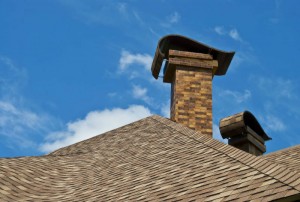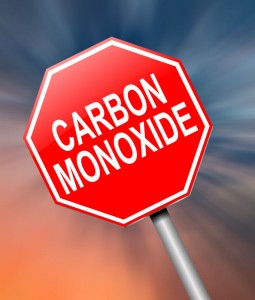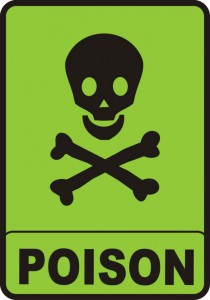by Billy Sweet | Feb 19, 2019 | Creosote
Many homeowners across the U.S. have been using their fireplaces for several weeks. In that time, the fires have produced soot consistently, and wood fires produce creosote as well. Every fire that burns wood will produce creosote because it is a natural byproduct, but how much creosote is produced will depend on the type of wood you burn.
The Problem with Creosote
Creosote can be no problem as long as it’s cleaned on a regular basis. When cleaned regularly, creosote can be removed safely by a professional using brushes and a vacuuming system during a routine chimney sweep. When these important services are neglected, the sticky creosote can buildup and lead to an obstruction that slows down the air in the chimney system. When homeowners continue to use a dirty system, the airflow slows significantly and the high temperatures cause the creosote to boil and the water in it to evaporate. Once the water evaporates, what is left is a dense, hard mass of concentrated tar–a highly flammable material left right in the line of fire.
Glazed Creosote
A level three creosote buildup is called “glazed creosote” because the creosote takes on a hardened, shiny look after repeated heating and cooling. As the creosote problem worsens, the airflow slows and heated air lingers in the flue, raising the risk of flue fire. When glazed creosote ignites, it results in an intense, fast burning fire that expends a large amount of gas and energy. This burst of energy can crack the flue liner, damage the masonry, and spread to other parts of the house. Other times a flue fire can occur and a homeowner won’t even notice. It’s important to schedule a chimney inspection if you suspect a flue fire. The first flue fire may damage the system, and a second flue fire can travel through damaged masonry to the rest of the house.
Glazed Creosote Removal
Soot and creosote is easily removed during a routine chimney sweep. Glazed creosote, however, cannot be removed using the same methods. Some amateurs may attempt to remove the creosote by prying it away, but this never removes it completely and even leaves scratches and other damage to the liner. Hire a professional who knows the safe and proper methods for glazed creosote removal. At Billy Sweet Chimney Sweep we use industrial products to safely remove glazed creosote without leaving any damage to the system. This trusted product can be sprayed or wiped onto the glazed creosote. As it’s absorbed, the creosote flakes away and can be swept away and collected just like soot.
Prevent Creosote Buildup
You can prevent a dangerous and dirty chimney system by scheduling professional services annually and using your system properly.
-Schedule routine chimney sweeps to clean the flue of soot and creosote before a buildup occurs.
-Burn only properly seasoned wood. Green or fresh wood produces more creosote while burning.
-Schedule chimney inspections annually so you can rest assured your system is working properly and the wood is burning completely.
-Pay attention to signs such as flakes in the fireplace or slick, black material on the masonry.
Schedule services with the licensed professionals at Billy Sweet Chimney Sweep today. Call 617-469-4528 or schedule online.
by Billy Sweet | Jun 30, 2015 | Summer Chimney Sweeping
Summertime is here, and homeowners are switching on the A/C, spending time outdoors and searching for ways to fight the heat. It’s no surprise that the state of your fireplace is probably the last thing on your mind; after all, you won’t be utilizing it again for at least a few months.
Once September rolls around, however, the temperatures can drop sharply, leading homeowners to consider utilizing their fireplaces for warmth and relaxation.
Unfortunately, many homeowners are unaware of the importance of having their chimney swept before starting that first autumn fire.
Check out these important reasons to get your chimney swept before the fall.

Avoid the Rush
Once fall arrives, chimney sweeps are very busy; their schedules are typically backed up for days or even weeks at a time. Waiting until fall to schedule your sweeping could mean a long delay or having to shop around for another company that can accommodate you.
You can avoid the rush by getting your chimney swept before fall arrives. You won’t have to wait for an opening, and you can head into the colder season knowing your fireplace is ready for use.
Prevent Chimney Fires
Your chimney functions as the avenue through which dangerous flue gases and other fireplace by-products can pass safely out of your home.
These by-products include water vapor, hydrocarbon, wood particles, smoke, and tar fog, among others. As these by-products flow up through your chimney and mingle with the cooler temperatures at the top, condensation occurs, resulting in a tar-like coating on the walls of your chimney known as creosote.
Creosote is highly combustible, and building a fire in your fireplace when it has an excess buildup of creosote on its walls puts you at serious risk for a chimney fire. Getting your chimney swept regularly, and especially after a long summer of not using your fireplace, is the easiest way to get rid of creosote and prevent a chimney fire.
Prevent Unpleasant Odors
One of the main reasons homeowners invest in a fireplace is to add ambiance and luxury to their home; unfortunately, for homeowners who fail to keep their chimney clean, an unpleasant odor may begin seeping from their fireplaces into their homes during the summer months.
The heat and humidity of summer weather can cause reactions in the creosote and by-products of a dirty chimney, causing the emission of a sour, burnt odor that no homeowner wants to experience.
Getting your chimney cleaned during the summer can help minimize the presence of these bad odors and keep your home clean and comfortable.
Prevent Life-Threatening Gases from Accumulating in Your Home
A blocked or malfunctioning chimney is one of the leading causes of the accumulation of carbon monoxide in homes; in fact, carbon monoxide poisoning is responsible for 200 deaths in the United States each year.
It is essential that you get your chimney swept on a regular basis, to ensure that your flue is venting and functioning properly. A regular sweeping will also prevent the accumulation of creosote, acidic water vapors and soot that can cause chimney blockages and thus the dangerous accumulation of noxious, life-threatening gases in your home.
Extend the Life of Your Fireplace
The accumulation of fire by-products in your chimney can cause damage to the structure of your chimney, your home and your fireplace. You’ve made an expensive investment and deserve to enjoy its benefits for years to come.
by Billy Sweet | Mar 27, 2015 | Carbon Monoxide Poisoning
Carbon monoxide is a dangerous gas that can cause poisoning when you are exposed to it. It is a particularly dangerous threat because it is odorless, colorless and otherwise undetectable to the naked eye. When you are exposed to carbon monoxide you inhale the fumes, which prevents oxygen from reaching your organs. The most important thing you can do to protect you and your family from carbon monoxide dangers is to prevent exposure in the first place.

How Does Carbon Monoxide Poisoning Occur?
Carbon monoxide poisoning occurs in several ways, but in residential homes the most common way is through the misuse of heating appliances. In homes where wood-burning heating appliances are used, by-products can be left behind in chimneys. Soot, animal debris and flaked off masonry can all lead to dangerous toxins being release inside the home. Additionally, homes that aren’t well-ventilated can lead to carbon monoxide poisoning because there isn’t efficient air-flow while heating appliances are in use. Lastly, misuse of heating appliances can lead to poisoning, especially if inappropriate materials are being used or the operator doesn’t understand all components of the appliance.
Damaged Chimneys Can Lead To Carbon Monoxide Dangers
In homes where chimneys are older or have not been properly maintained chimneys can become blocked or rusted and this can result in carbon monoxide and other toxins being released into the air. Backdrafting, a common occurrence when chimney dampers and flues are not operating properly, can also lead to carbon monoxide poisoning.
Symptoms Of Carbon Monoxide Poisoning
If you suspect you or someone in your home is suffering from carbon monoxide poisoning, look for these common symptoms:
- Headache
- Weakness
- Dizziness
- Confusion
- Loss of vision
- Loss of consciousness
While these symptoms may seem subtle, they are life threatening. If you see any of these symptoms, remove everyone from the area and get emergency medical care immediately.
Luckily for homeowners, there are ways to prevent carbon monoxide poisoning including:
- Invest in a carbon monoxide detector that will alert you if the dangerous gas is detected.
- Never use stand-alone heating appliances like space heaters in small, enclosed areas.
- Only use wood-burning appliances in well-ventilated areas.
- Make sure you understand how to operate ALL components of your chimney before you light your first fire.
- Only burn appropriate, chemical and paint free wood in your wood-burning appliance.
- Inspect your heating equipment before use to make sure it is operating properly.
The single most important thing you can do as a homeowner is have your chimney professionally swept and inspected at least once a year. Hire a professional and experienced chimney sweeping company like Billy Sweet Chimney Sweep serving the Boston, North Shore and Portland areas to inspect, repair and if necessary, rebuild your chimney. Having an airtight chimney with a working damper and flue is the best way to prevent carbon monoxide build-up from your heating system. Our certified chimney sweeps are ready to inspect your chimneys and recommend any necessary add-ons or repairs. Contact the best in chimney sweeping to keep your home free of carbon monoxide dangers.
by Billy Sweet | Nov 15, 2014 | Carbon Monoxide
Many parts of the country have already seen snowfall this year, which only means that winter is fast approaching. With weather experts forecasting another frigid winter, everyone’s focus has turned to staying warm for the season. When leaving the house, staying warm involves bundling up and protecting your skin from the bitter air. Keeping warm indoors, however, has a different set of requirements. Most homes utilize a heating source that burns fuel like propane, wood, pellets, oil, and other biofuels. As with burning anything, there always involves a safety risk. One major safety risk everyone should learn about in carbon monoxide.

This minuscule molecule made up of one carbon atom and one oxygen atom may sound innocuous on its own, but when it shows up in large quantities, you need to worry. Carbon monoxide results anytime combustion occurs, meaning whenever something burns. Therefore, any fuel burning creates carbon monoxide, including gas ranges, car exhausts, furnaces, fireplace, and even lanterns. If this burning occurs in a closed space, the concentration of carbon monoxide quickly rises. For this reason, starting your car inside a closed garage is very dangerous. Making it even more sinister is the fact that you cannot detect the colorless, odorless, tasteless gas without the help of a special detector. Consequently, the poisoning effects of the gas on the human body can disable a person before he or she realizes what the issue could be.
You can recognize the start of carbon monoxide poisoning with signs like difficulty breathing, light headedness and nausea. Unfortunately, these symptoms reflect many other illnesses, making carbon monoxide poisoning a far thought. When inhaled, the small molecule blocks the oxygen from being distributed around the body, resulting in unconsciousness, organ failure and even death. To stop and potentially reverse the damage, the person suffering from the poisoning must have access to clean air in an open outdoor space.
The mighty power of this invisible gas makes it a threat that demands respect. Whether you use a fireplace, stove, or gas furnace this season to heat your home, recognize the dangers of carbon monoxide. Install detectors for safety – not just because it is the law – and learn the signs of poisoning. Insuring your heating appliance is functioning properly also goes a long way in preventing carbon monoxide from filling your home. Something as minor as a misfiring furnace or an obstructed chimney could mean the difference between life and death. Instead of risking poisoning, have an expert out to conduct a thorough safety inspection of your heating appliance. If you live in the Boston or North Shore area of Massachusetts or around Portland, Maine, contact Billy Sweet Chimney Sweep to speak with an expert you can trust.
by Billy Sweet | Oct 10, 2013 | Chimney Maintenance
Don’t Let Air Quality Issues Keep You From Enjoying Your Fireplace
The first sign of an air quality issue relating to your home heating appliance is usually smoke: the smell of it, or sight of it billowing into your room. If someone in your home is struggling with respiratory issues like asthma, errant smoke will quickly — and very negatively — affect their lives. For starters, smoke carries particulates from unburned fuel that can aggravate respiratory systems. But what you can see and smell isn’t all you should be concerned about. Carbon monoxide is colorless, odorless and toxic, and if smoke is coming into your living area, there’s a good chance excess CO is in there, too.

When smoke is coming out of your fireplace, there are also hazardous gasses flowing in as well. You could have a draft problem.
When your chimney is working the way it should — when proper draft is pulling all of the byproducts of combustion up and expelling them from your home — air quality shouldn’t be an issue. So less-than-clear air is an indicator that there’s a problem in your system. Billy Sweet Chimney Sweep technicians can figure out your specific problem, and share solutions, during a chimney inspection. But here are some things to think about, which can help maintain or improve your air quality, in the meantime.
Solutions To Air Quality Issues
Keep Current With Regular Maintenance
Dirty flues will impede draft and prevent your chimney from venting properly, leading to smoke intrusion. Gaps and other kinds of damage can let gases leak into your living area. The best way to know that your chimney is clean and that cracks or gaps aren’t allowing particles and gases to leak is to stay current with your routine maintenance.
Your best practice: Schedule a chimney sweeping and inspection appointment once a year, ahead of the heating season, and have any areas of damage — from flue liner cracks to stuck dampers — repaired before you begin regularly using your appliance. With Billy Sweet Chimney Sweep, your sweeping and inspection go together — we sweep every chimney we inspect, so we can get a clean and clear look at the state of the appliance and flue. We also video scan the flue to get the closest look possible — and we’re able to visually and clearly share our findings with you, too.
Replace An Old, Inefficient Appliance With A New, EPA-Certified One
Older stoves and fireplaces, including masonry fireplaces, can be highly inefficient, and our industry has taken incredible strides in improving emission levels over the years. EPA-certified wood stoves, fireplaces and inserts made and sold today are built to create the optimum environment for fuel burning — and near complete combustion makes smoke almost nonexistent. EPA guidelines require these appliances to emit less than 7.5 grams of particulate per hour. Older units often give off as much as 42 grams per hour — a pretty remarkable difference.
A properly functioning, EPA-certified appliance — one that’s sized properly for the space, with a properly sized and installed flue — can make a really noticeable difference when it comes to the air quality in your home.
Be Particular About Your Fuel
Steer clear of burning green wood or anything else that isn’t seasoned or kiln-dried cordwood. Pressure-treated wood and lots of other materials (like plastic) can give off dangerous fumes when burned. And wood that hasn’t been dried properly (at least six months to a year) will give off far more smoke, negatively affecting your air quality.
Give us a call — Billy Sweet Chimney Sweep techs can share other methods for keeping your chimney system working its best, and if any problems do come up, we’re here to fix them.





